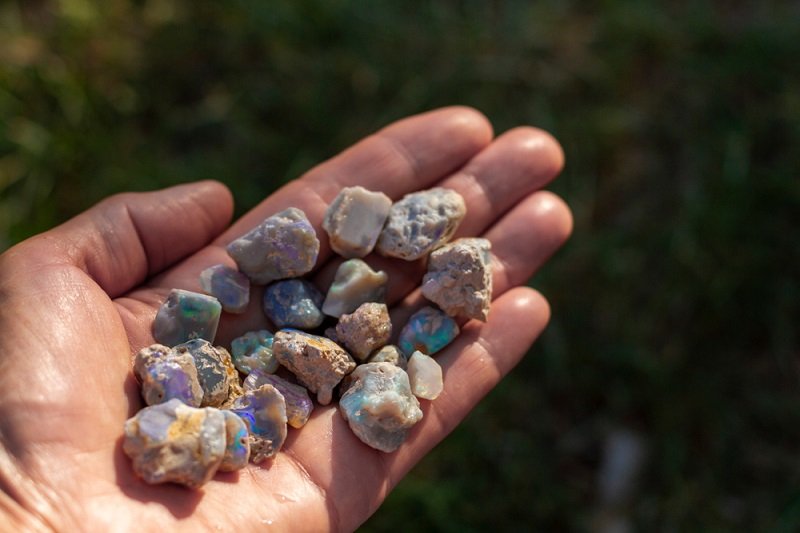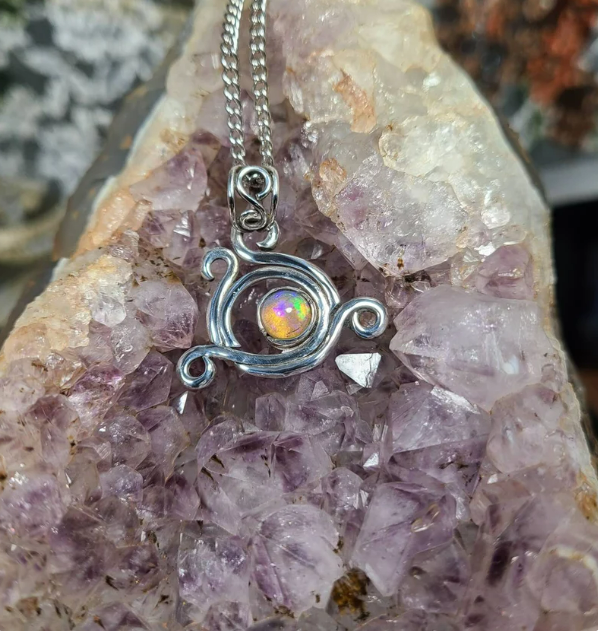Opals are a prime target for collectors. Contained within their crystals are worlds of fire, colored patterns, and wonder. Even common opal, with its light, milky colors is an awesome mineral. For collectors, the problem is where to begin.
Let’s get into it. We’re going to give you a crash course in collectin opals, running from what they are to how to pick them out in the field.
What Are Opals?
Opals, as a mineral, are comprised of SiO₂(or silica) with a high percentage of water. Opal is actually amorphous, like glass, rather than a true crystal.
It’s a common find in nature. Opal is deposited at low temperatures and pressures compared to crystalline forms of silica. The moisture percentage ranges from 3% to 21%, but most are on the lower side. 6%-10% is most common.
Opal is divided into two major classes.
Common opal is solid-colored, usually within the same hue. The colors tend to be muted, and there’s also a lot of white opals out there. Some common opal has a bit of clarity and inclusions like dendrites but it’s most often pretty solid.
Precious opal, on the other hand, displays a fiery interior. The more fire, the more precious an opal usually is.
But despite the wide variety, the truth is that all opal is comprised of mostly the same stuff. Opal is defined as amorphous, hydrated silica.
What Types of Opal Are There?
As noted above, there are two main varieties of opal. Many collectors go for both, and there’s a lot of variety within each group.
Common Opal
Common opal ranges from white to pink to red to green. The colors of all of these opals tend to be solid, with minor translucency in some cases.
The most common opal has a characteristic glint on the surface when polished and shaped. It doesn’t compare to the fire of precious opal but it’s a pretty optical property.
Some fossilized opal also comes into this category. Opalized wood is fairly common, for instance. Silica and water tend to fill things in, and when the conditions are right… well, we get opal.
For the collector there are a few varieties to keep an eye out for:
- Dendritic Opal- Dendritic common opal is usually white, and black tree formations emerge on the surface.
- Peruvian Common Opal- A wide variety of colors exists within Peru. Peruvian opal is usually soft in color. Pink and blue are the most common colors in this region, but it varies widely.
- Agate Opal- Opaque opal deposits that have banding resembling agates.
- Green Opal- A variety of common opal commonly found in Madagascar. It ranges from lime to olive green, often with spotted patterns.
- Madagascar Opal- Dark brown and black opal, often with white banding in between sections.
Common opal of unknown provenance is usually just called by its color or pattern.
Precious Opal
Precious opal is an amazing stone, and it usually has a cost to match. The difference is that this form of opal has a play of color that moves within the stone as the light hits different angles. It creates a flashing effect in jewelry that’s considered highly desirable.
Precious opal is named for its origin in most cases.
The most common varieties seen on the market are Australian and Ethiopian Opal.
Australian Opal is very stable and often has strong flashing colors. The region known as Lightning Ridge produces some of the finest black opals in the world, along with precious fossilized opals and fire opals.
Ethiopian Opal can be distinguished by a waxy texture. While less stable and fiery than Australian Opal it has a lower price tag and has become common in jewelry. They’re commonly called Welo Opals as well, and they tend to have high clarity along with their colors.
Mexican Fire Opal is the other main source. It often occurs in small pockets, and cutters will leave the matrix surrounding it to create a framed effect. These opals are usually deep orange and clear.
Other precious opals occur sporadically as well.
In addition to origin, opals are sometimes assigned descriptive names. These vary based on the vendor and usually just describe the color of the stone. In some cases, like the famed Harlequin Opal, it boils down to a specific pattern in the play of color.
Treated and Man-Made Opals
More than one person new to collecting has been burned by an opal dealer. Like all precious stones, it can be a buyer-beware situation.
Man-made opals are sometimes passed as opal to the unwary. The easiest way to identify them is by a regular pattern, often with columns and lines being the main feature. Under a 10x loupe you may also note a cellular appearance in the pattern.
For that reason, it’s important to trust your source, especially when you’re new to collecting.
Other opals are treated in some way.
The most common bait-and-switch played on collectors is with smoked opal.
These stones are sometimes sold as “Black Ethiopian Opal” but they’re inevitably treated. Actual Ethiopian Black Opals are extremely rare, and aren’t affordable for the average collector.
Instead, you’ll usually receive a low-to-mid grade opal that’s undergone a smoking treatment. The process is pretty simple: the opal is wrapped in paper, and everything is heated until the paper begins to burn.
The resulting carbon deposit in the opal darkens the material, allowing for the internal fire to be seen more clearly. It can result in beautiful stones, but they are treated.
Price is usually the best way to determine if an opal is treated or man-made. If it looks too good to be true, it probably is. If you want to keep your selection natural, then you should be careful what you purchase online.
Where Can I Find Opal?
Opal is found across the world, but not all of it is valuable or sought after by collectors.
The big hotspots for opal mining are in Peru, Madagascar, and Australia.
Of course, you’re never out of luck entirely when it comes to rocks in the United States. Opal is found across the county, but the best spots are located in:
- Nevada
- Oregon
- Idaho
For tourists on the hunt for stones, Virgin Valley in Nevada is your best bet. They offer fee digs on a couple of their mines. The opal from the area includes a fiery black variety.
You can find fee digs in Oregon and Idaho as well, but you won’t have a chance at black opal.
How Do I Find Opal in the Field?

Opal is most commonly found in areas that it’s being mined. You may occasionally find smaller pieces of opal while hunting for jasper or agate, but not in enough quantity to be worth a trip if you’re not interested in other stones.
A dig site is really your best bet.
Here’s what you need to know before you get out there.
Gearing Up
You’ll need the usual tools:
- Rock Pick
- Pocket Knife
- Safety Glasses
- Shovel
- Pickaxe
- Hard Hat
You won’t need a pickaxe or hard hat if you’re working in tailings.
Always bring along water and food as well. Most areas you’ll be digging are hot, and dehydration is a serious matter. Likewise, you’ll need something to eat since you’ll be doing some physical work.
Most dig sites will let you rent equipment, or even sell it in their gift stores. I recommend using your own tools and purchasing them in advance. Estwing is the preferred brand for most rockhounds, I’d suggest looking there first.
Digging Tailings
The most common is to go into the “tailings” of the mine. This is dirt, clay, and stone that’s been excavated from other areas moved to make a new bank clear. It takes the form of a lot of spread-out, smaller material.
These digs are cheaper than others, and you can still find impressive material with some luck.
Hitting tailings can be a mixed bag. You’re often getting a second look at the material after all, but smaller nodules can be easy to mix.
Use a rake to spread the material out, looking for any sort of shine. It’s best to just get yourself a pile of larger dirt clods and rocks.
Break up any larger pieces of stone or dirt with your rock pick afterward. A lot of opal gets missed in large chunks and they’ll be your best bet.
You may also find smaller chunks not embedded in anything, so keep an eye out while you’re building up a pile to crack open.
Mining Banks
Mining banks is a lot more work, but the payoff is usually better. If you’re hoping to make any money out of your day trip it’s your best bet.
You’ll need to observe a couple of basic rules to be safe when mining:
- Keep your safety glasses and helmet on at all times. Both can turn what should be a serious injury into a non-issue and rock reacts unpredictably under force.
- Mine evenly along the bank. If you undercut the earth you run the risk of a collapse that could hurt you or others near you.
Common sense precautions aside, you should carefully sort your specimens.
When you’re digging, you should listen for a characteristic clink. Hitting opal will sound like you’ve struck a chunk of glass, it’s very distinct.
Once you’ve found a nodule you’ll want to slowly uncover it. Switch to a chisel or a rock pick and carefully dig around the opal until you can pry it loose from the host.
It’s an exhausting task, but a rewarding one. It’s always nice to know that one of your new specimens was also something you pulled from the earth!
- Online rock and mineral club for collectors of all levels!
- Find community with like-minded rock and mineral enthusiasts.
- Monthly Giveaways!
- Free Access to Entire Digital Library of Products (current and future products)*



